When you’re out camping or hiking and old man winter strikes with an unexpected fury, it can be challenging to stay safe, much less comfortable. Sudden temperature and weather shifts can transform a chilly day outside into a harrowing or even deadly incident, especially for those who are caught underprepared. But don’t worry — even if you’re not acclimated to harsh winter weather, there are a few easy cold weather tips to make any outdoor experience more enjoyable. In this article, we’ll explore them together.
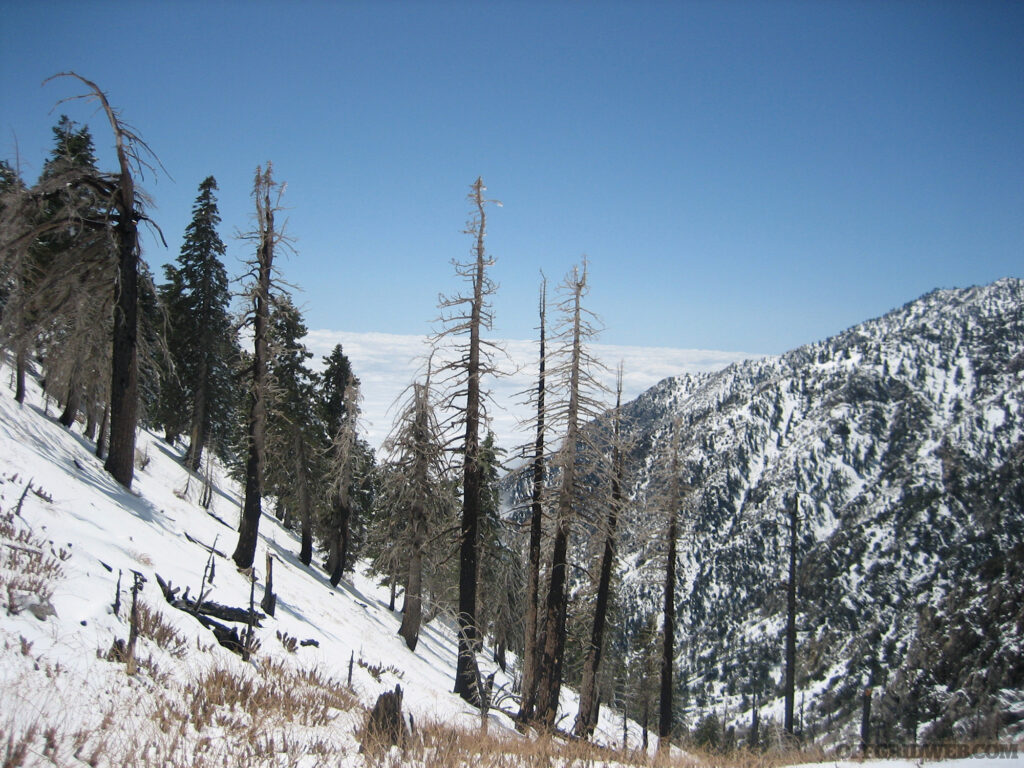
Remember the Basics
There’s no denying the incredible experiences and unforgettable moments that can be had in the great outdoors during the winter months, despite the cold temperatures. And while some of the basic rules may seem like common sense, they’re absolutely essential to ensure a safe and enjoyable trip. So, let’s briefly cover the basics and equip ourselves to tackle any cold-weather adventure.
Layer Up
You’ll enjoy any trip a whole lot more if you keep yourself warm. However, that doesn’t mean you should just throw a heavy coat over your everyday T-shirt and call it good enough. It’s best to wear multiple layers of clothing that trap air and insulate your body. Start with a base layer of wool or synthetic material that wicks moisture away from your skin; avoid cotton, as it absorbs sweat and loses its insulative properties. Next, wear a mid-layer of fleece or wool for added warmth. Finally, wear an outer layer of waterproof and windproof material that shields you from the elements. Remember to cover your head, hands, and feet with hats, gloves, and socks made of materials other than cotton.
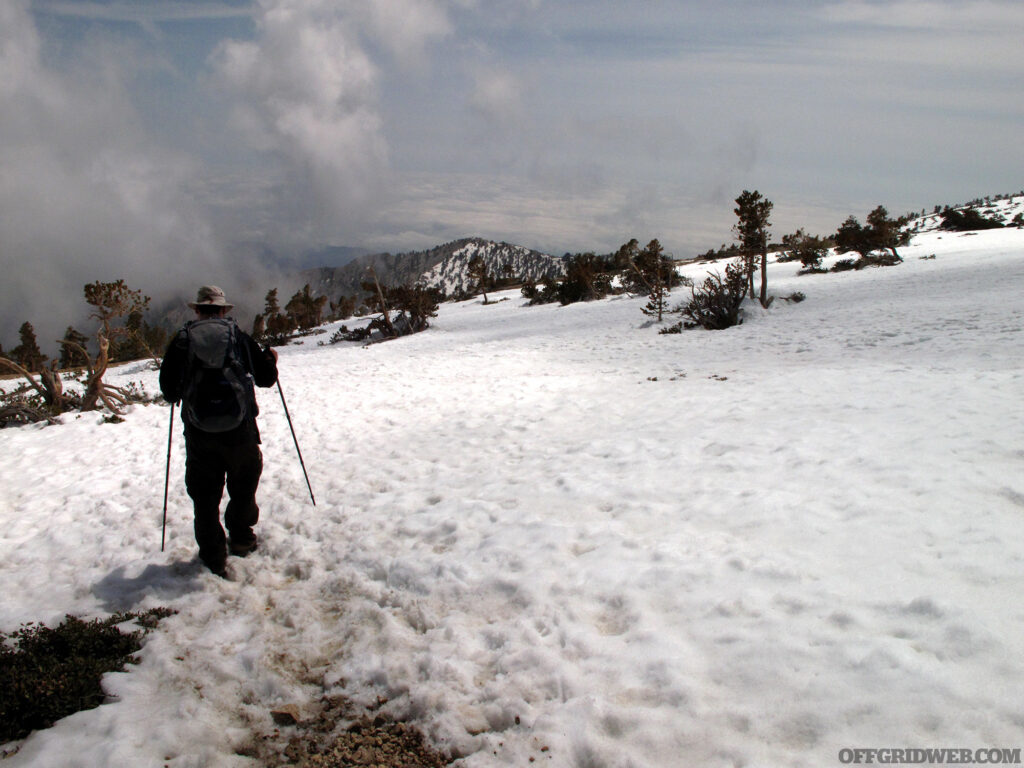
Above: After finding his way out of a freak blizzard overnight, the author reflects on his winter experience in California’s Angeles National Forest.
Stay Dry
This point goes hand-in-hand with the last one. Getting wet can lower your body temperature and increase your risk of hypothermia. Avoid sweating by removing layers if you begin to overheat and reduce your level of physical exertion if necessary. If you get wet from rain, snow, or sweat, change into dry clothes as soon as possible. Keep your sleeping bag (or camper’s quilt, blanket, etc.) and gear dry by storing them in waterproof pack liners or bags. Bring extra socks and dry the wet pairs out by the campfire, because there are few things more miserable than cold, wet feet.
Eat and Drink Well
Your body needs more calories to stay warm in cold weather. Eat high-energy foods rich in carbohydrates, fats, and proteins, such as nuts, dried fruits, chocolate, cheese, and granola bars. When going on a winter camping trip or day hike, it is recommended to consume high-calorie foods with fats as they can help keep your body warm. As you hike, your body will metabolize the food and generate heat.
It’s also essential to pay attention to the importance of staying hydrated during cold weather. Though people might not associate winter with being thirsty, it’s crucial to drink water to keep your body functioning correctly. Avoid eating snow as a replacement for water, as it’ll cool you down instead of warming you up. Instead, melt it in a kettle or metal water bottle and drink it. Keep drinking water close enough to your body to prevent it from freezing or keep it near a campfire.
It’s also advisable to take advantage of cooking hot meals and drinking warm beverages before sleeping. They can help you stay warmer than uncooked food and dehydrated snacks. Make pine needle, spruce, or hemlock tea for a hot vitamin C-infused drink. However, it’s wise to avoid consuming alcoholic beverages like beer and hard cider as they can cause multiple trips to the bathroom, leading to a loss of the warm microclimate you’ve been painstakingly creating.
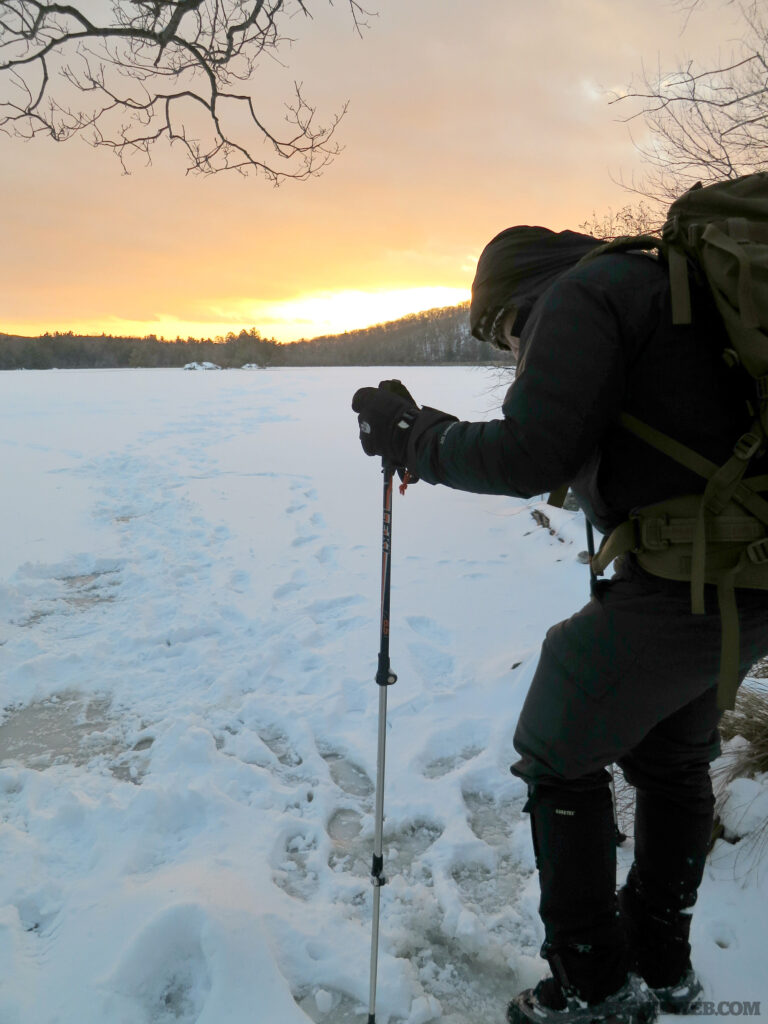
Above: Cold weather winter outings must be taken seriously. Equip yourself physically and mentally for when Mother Nature gets pissed.
Be Ready for the Unexpected
Let’s say you’ve done your best and followed as many pre-planning tips as possible, yet the weather changes. It happens. Several years ago, I went on a backpacking trip in the Angeles National Forest in California. Back then, the snowline was about 6,500 feet — we were at only 4,000 feet. This was early November in a state that’s not known for rain or snow, in general. We hiked in with sunglasses and the sun on our faces. Later that night, we heard the sound of a light pitter-patter on our tarps as we hung in our hammocks enjoying the late autumn night. Eventually, the light tapping turned into a tin roof cat dance, and it was coming down hard. I told my cousin to pull the tarp over tight as it started to sprinkle before it was a full-on rain — or so we thought.
After about 40 minutes of it, nature called, as it often abruptly does in the worst of times. I pulled the tarp back and turned in the sitting position to grab my shoes. To my surprise, I saw a sea of white powder. It wasn’t sprinkling, nor was it ever raining — we had snow. It was 1 a.m., and the thought of “What will we do tomorrow?” hit hard. Expected lows of 50 degrees F became 20 degrees. It was time to act. What would you do in this situation?
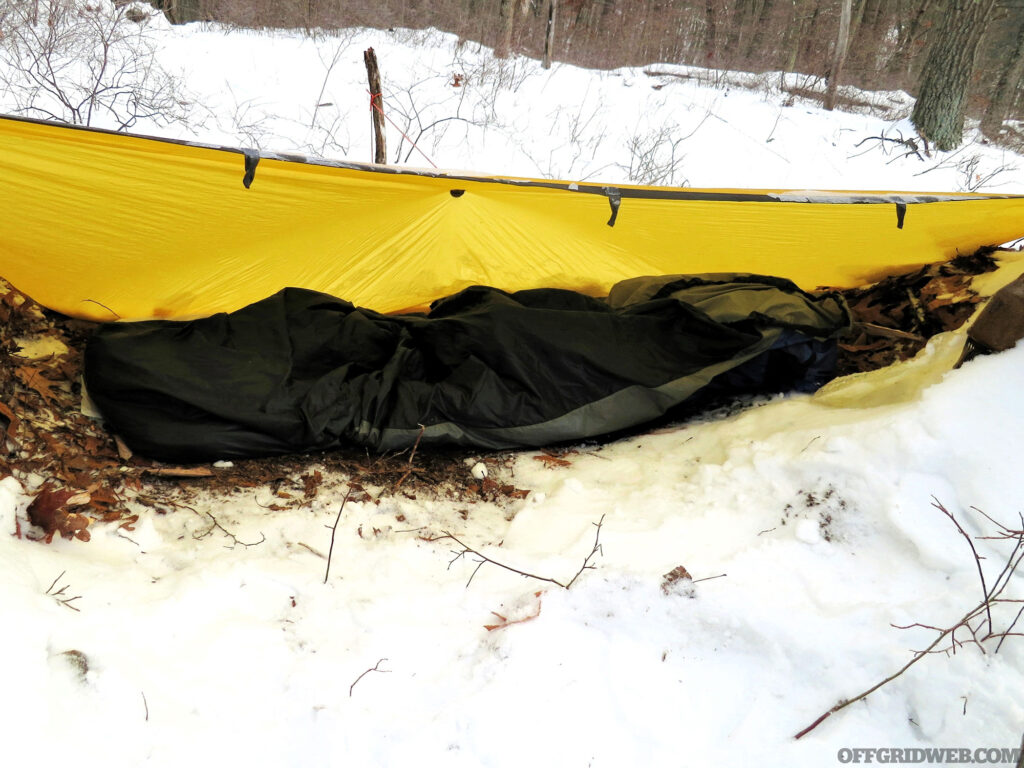
Above: Throughout the night, the author remained comfortable while sheltered under a tarp (with bivy) that effectively prevented heat loss. Despite the temperature dropping to 8 degrees F and the continuous onslaught of wind-blown rain and snow, he stayed warm and dry.
Stay Active
Waking up cold sucks. Waking up freezing in a blizzard is serious business. It’s common to wake up in the middle of the night while camping, especially if you need to pee. Remember that your body stays warm naturally through movement and digestion, so it may be helpful to get up and start moving around. Make sure you have a saw and a large piece of wood to saw and help create heat before you attempt to go back to sleep. Building a campfire can also be a great way to warm yourself up. Take advantage of the opportunity to warm up water for your water bottle or hydration bag. Once you’re feeling warm and cozy, you can try to get back to sleep.
Moving around can help you generate heat and improve your blood flow. Do simple exercises, such as jumping jacks, squats, or push-ups to warm up your muscles and joints. However, keep yourself from overheating and sweating profusely.
An old-timer’s trick used by experienced campers is to carry a candle in a pocket. When taking a break from hiking or setting up camp, they would light the candle and sit upright while draping a coat or blanket over themselves. This helps trap the heat from the candle and keep warm, making it a great way to thaw out and recharge quickly before continuing the hike.
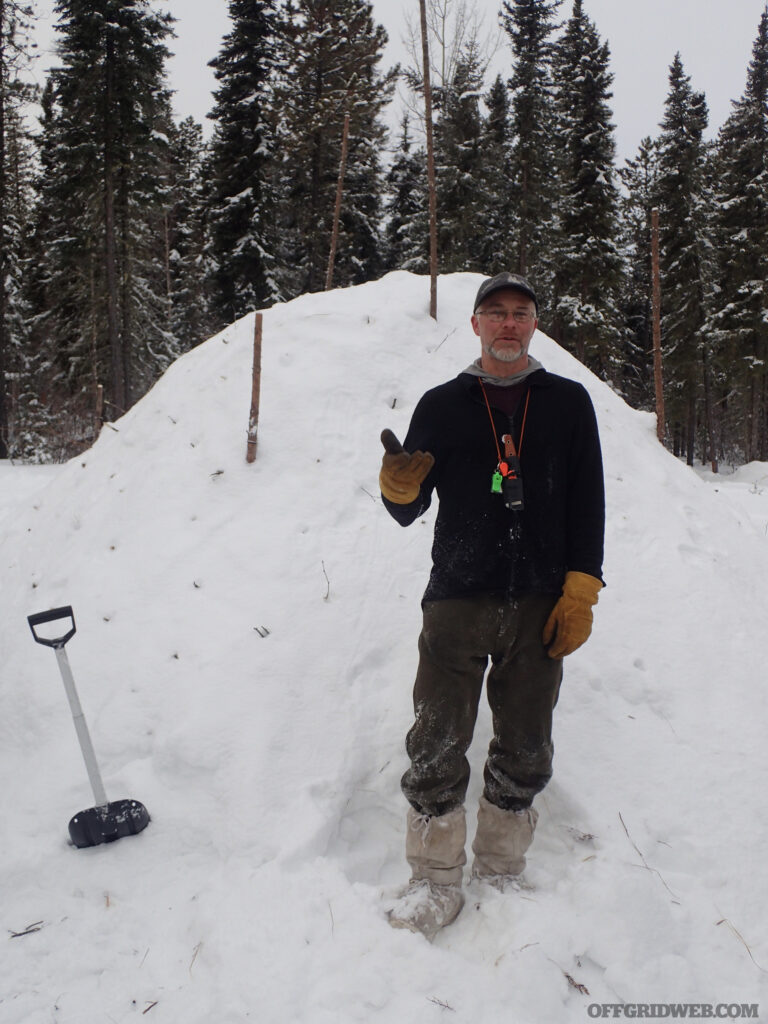
Above: Dale Kiselyk of Karamat Wilderness Ways in Canada stands outside a completed snow cave.
Seek Shelter
When you’re hiking and you get hit with an unexpected storm, it’s essential to find a sheltered spot. This can help you stay warm by blocking the wind and retaining heat. Good spots to consider include areas under trees, behind rocks, or in caves. However, it’s important to know about potential hazards, such as falling branches, rockslides, or wild animals.
If you have a tent, make sure to set it up on a flat and dry spot that’s away from water sources or low-lying areas. It’s also a good idea to use a ground cloth and pad to insulate yourself from the cold ground. This is more crucial than most people give proper attention to. Don’t neglect it! Before getting into your sleeping system, fluff it up and zip it to keep warm. Additionally, you can use a blanket, bivy sack, or emergency mylar blanket for extra warmth.
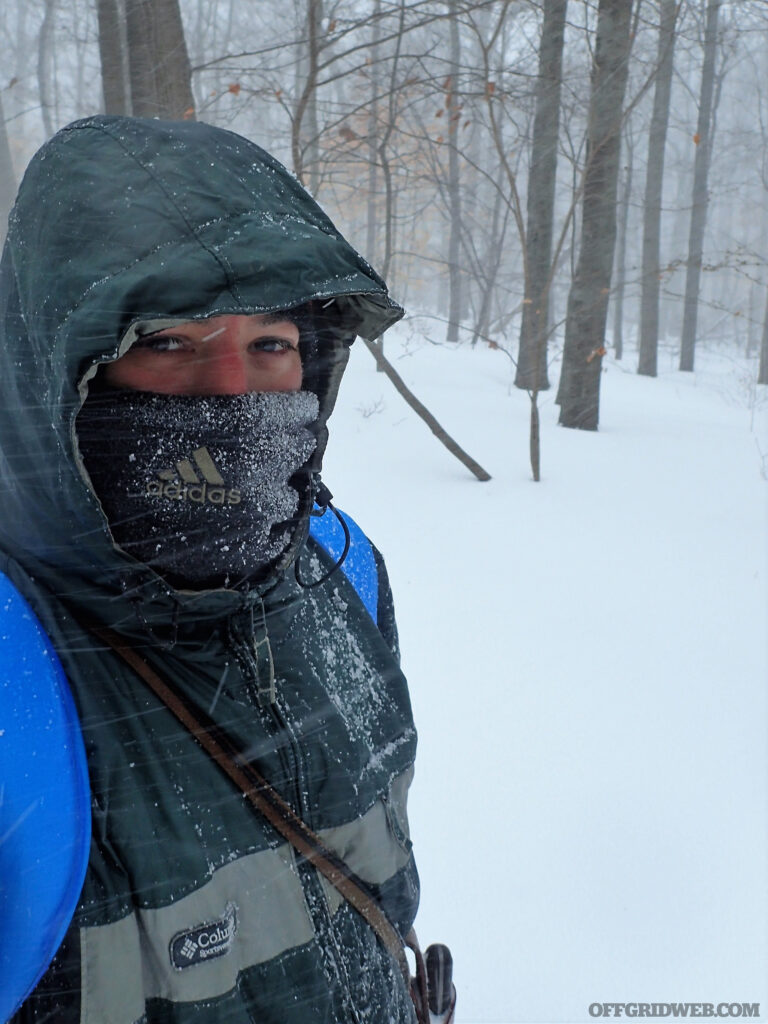
Above: After getting caught in a blizzard in the Northeast Woodlands, the author was properly equipped with warm clothing. To avoid frostbite and hypothermia, the author covers up completely to preserve body heat.
Hard Lessons Learned
One winter, I was fresh back from assisting a tracking/survival class in Louisiana on an Army base where the low was 50 degrees F. Afterward, I was flown to the East Coast with trail runners and deerskin bottom moccasins as my only footwear — in December. News said there would be a monumental blizzard closing in. Soon after, my phone lit up with a buddy saying, “Terrible storm closing in, I’ll pick you up at 7 a.m. to camp.” This was the first time I got frostbite.
We hiked in the cold, crisp air of the early East Coast winter, observing black bear and deer tracks. By the way, I chose the trail runners. Suddenly, the sky opened up, and icy rain and snow fell. Time to act.
In no time, the best of the worst campsites was selected, and we went to work establishing what would be our cozy impromptu camp. After clearing the ground of as much snow as we could, kicking it aside, it was time to bulk up on the ground insulation. Leaves and debris were covered with snow, but we had birch bark from nature’s store. The birch bark served double duty as a fire accelerant and ground padding. Large pieces of bark were used as insulation with my pack liner (a tall kitchen garbage bag), filled with frozen leaves harvested from under the snow. On top of all that, I placed my torso-sized closed-cell foam pad. It was enough to fight conduction from the cold ground. Tarps were set, and we quickly got a fire going to stave off the chill.
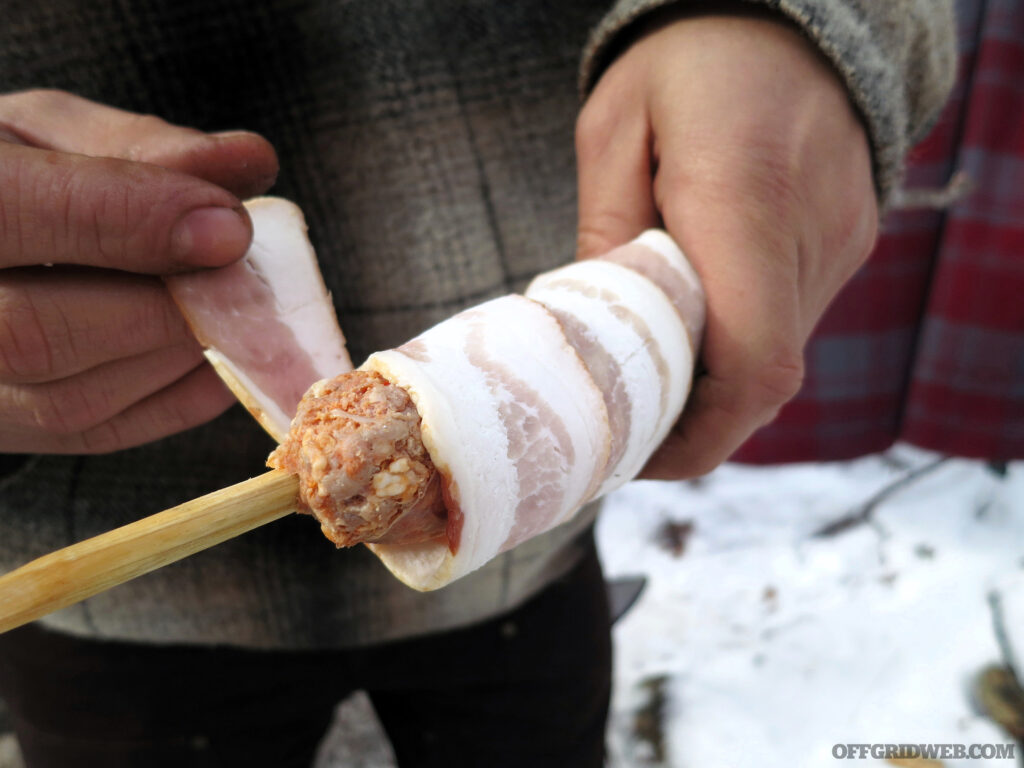
Above: Calorie-up for a winter trip and take advantage of high-caloric foods to help generate heat while asleep.
Hone Your Fire-Building Skills
When camping or surviving alone, fire can be a great companion. Not only does it boost morale, but fire preparation also provides us with a task that keeps us warm. Fire is one of the few things that can keep us entertained for long periods without speaking a single word. In fact, fire serves several vital purposes, such as warming us up, drying clothes, boiling water, and cooking food — especially during the winter.
It’s always a good idea to keep at least three ways of starting a fire on hand, especially in colder weather when a fire can be a lifesaver. A ferrocerium (ferro) rod, stormproof matches, and a lighter are all examples of items that can help with ignition. However, building and maintaining a fire must be practiced to ensure you can successfully get one going when it matters most.
When camping in cold weather, it’s vital to lay down a wooden platform first to serve as a base for the fire. This is especially true if there’s ice, snow, or moisture from rain on the ground. The forest floor is the coldest thing around, and it can quickly drain the heat from our fire. By laying down wood, we can create a barrier between the fire and the cold ground. The wooden platform will eventually become part of the coal bed, so it’s best to choose hardwood if possible.
Practicing fire-building skills in places like a family car campsite, beach bonfire pit, or backyard can be a great way to prepare ourselves for camping in colder weather. These skills can come in handy in case of an emergency or if we want to impress our fellow cold-weather campers.
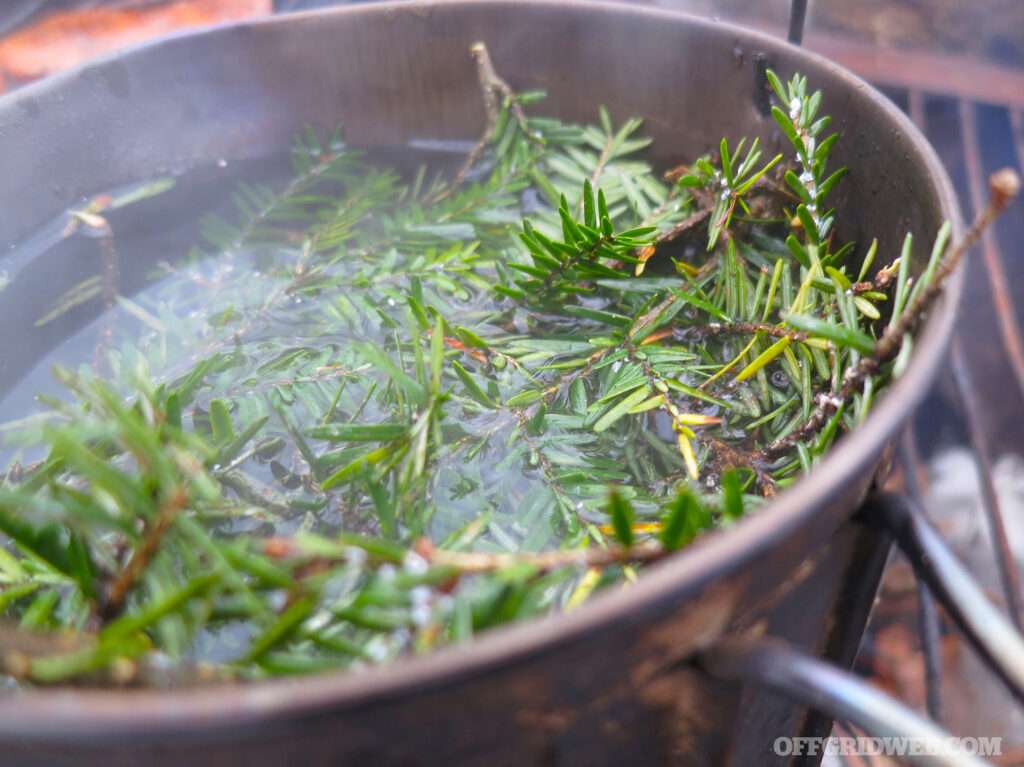
Above: Fire is used to melt snow and make Hemlock needle tea while providing warmth, hydration, and a healthy state of mind.
Six Ways to Improve Your Winter Sleep
- Urinate: As you prepare to settle down in your sleep system, it’s crucial to ensure that your body is warm enough to promote a good night’s sleep. One of the ways to achieve this is by emptying your bladder before you hit the sack. The reason behind this is that the body uses up a significant amount of heat to warm urine, which can be better used to keep the rest of your body warm and comfortable. So, urinate as much as possible to avoid any unnecessary heat loss that could lead to discomfort during the night.
- Hot Water Bottle: During cold winter nights, you can keep warm by filling a water bottle or hydration bladder with hot water. Place it at your feet, between your thighs, or near your torso to keep these areas cozy. If you have two water bottles, add another to increase the warmth. The best part is that you don’t have to get out of bed to drink water when you wake up.
- Change Socks: If you have a second pair of socks, changing them before bed is one of the best tips I can give. Feet can become damp due to rain, melted snow, or sweat. Therefore, it’s important to keep them dry and warm by changing into fresh socks. I always carry a pair of Arctic Carhartt socks in the winter, which feel incredibly warm and cozy to slip on at night.
- Bivy: Using a bivy bag while camping can benefit cold sleepers. It captures and retains body heat effectively, adding 5 to 10 degrees of warmth to your sleep system. However, it’s important to note that condensation may be an issue in colder weather if you don’t use a breathable bivy. Additionally, some people may feel confined in a bivy bag, so it’s worth trying a larger size to see if it suits your needs better.
- Beanie: Even a light beanie can do wonders in the cold. In fact, a Buff-style neck gaiter can double as an emergency beanie and help retain heat. I prefer Alpaca wool or fleece beanies and will never camp without one. Since essential body heat escapes through the neck and head, it can also be a reason why people get cold feet. The late survival guru Ron Hood used to say, “If you have cold feet, cover your head.”
- Ground Pad: A good ground pad is often overlooked in cold-weather gear. Heat loss to the ground can be a real issue. Even if you spend $300 or more on a high-quality sleeping bag, you may still end up freezing all night because you didn’t get a good sleeping pad or didn’t use one at all. I recommend using a closed-cell foam pad, which is lightweight, inexpensive, and nearly indestructible during regular use.
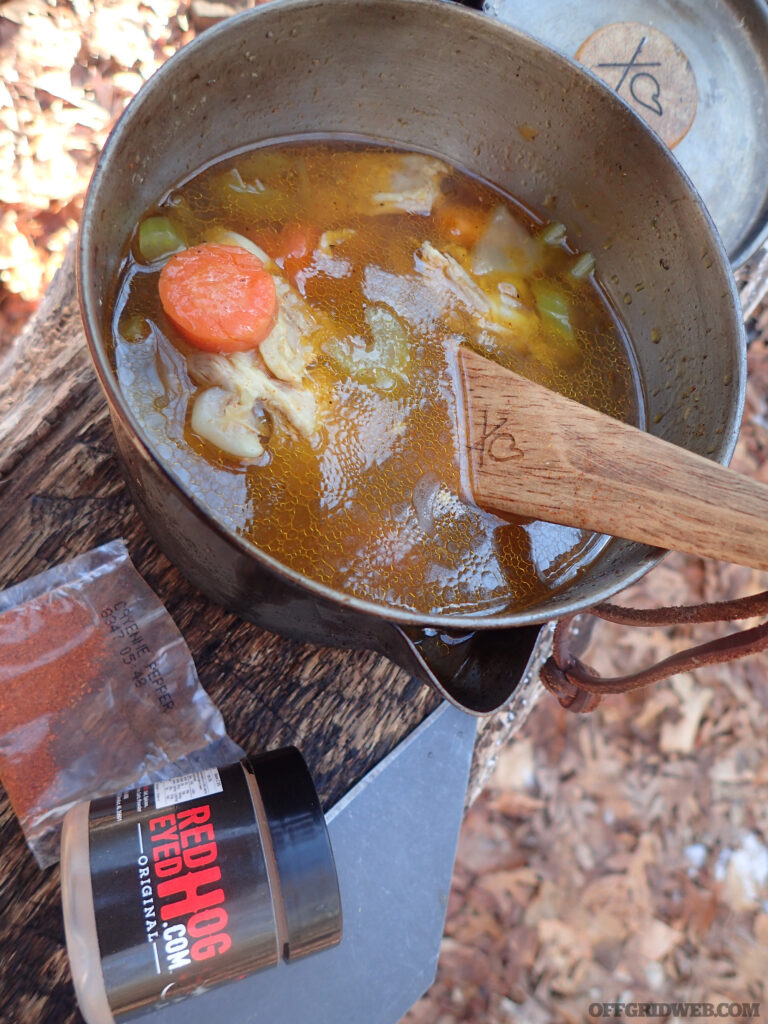
Above: Winter meals like stews and soups are not only comforting and warming but also packed with nutrients. Chicken soup and lentil stew are great options to try.
Five Heat Loss Mechanisms
It’s one thing to be cold and another to know why you’re cold. Understanding these five mechanisms will help you get one step closer to avoiding or preventing them.
- Conduction is felt by losing body heat when contacting colder surfaces, such as the ground.
- Convection is another way of saying wind; it saps the heat out of your body almost as fast as water.
- Radiation is heat loss through the skin into the air, especially your head and neck.
- Respiration is experienced when we exhale warm body heat.
- Perspiration/moisture is any water (such as sweat) that draws heat away from your body. The evaporation of this moisture also amplifies the effect of convection to further chill us.
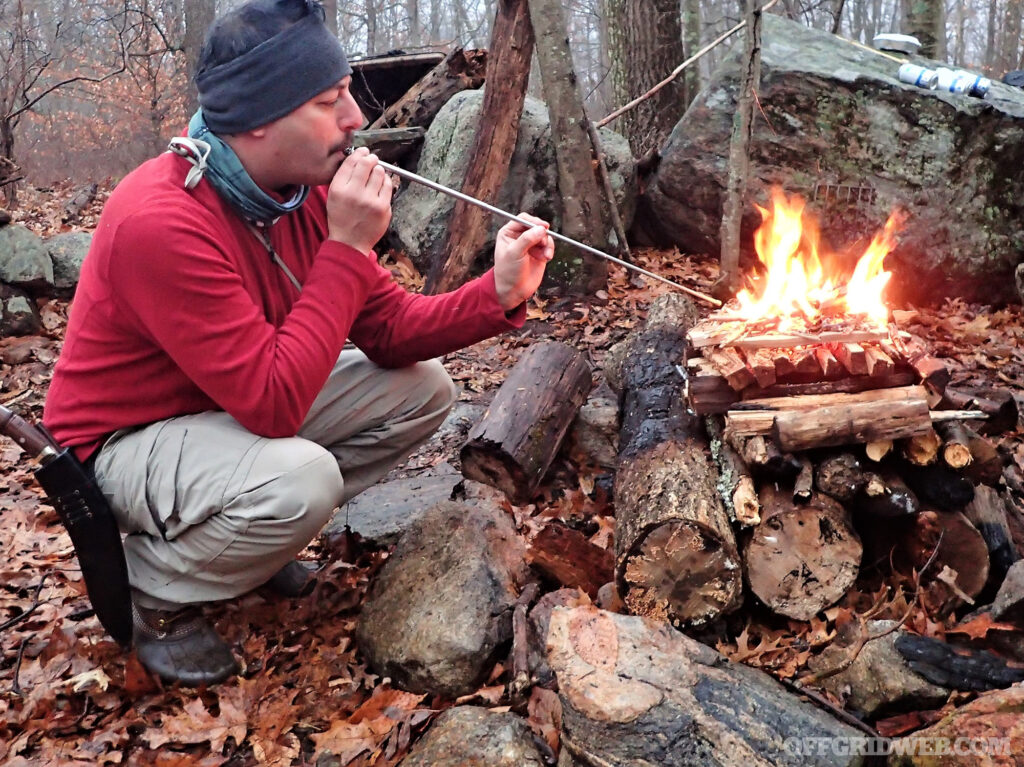
Above: When it comes to winter fires, make them big. The author starts a winter fire and maintains it throughout the night for warmth and cook coals.
Be Ready to Become a Cave-Dweller
If you actually get caught in the snow, be it a snowstorm or a place with deep snow, you may have to make a snow cave. This is grueling work and runs a high risk of overheating, but it could save your life if you don’t have another adequate shelter. Thick snow walls offer an insulated shelter and can keep you warm and safe from the elements. Digging a snow cave requires a shovel or sturdy metal cook pot to assist in the scooping of snow.
To make a snow cave, find an area with deep, compacted snow. Dig a hole in the snow that’s big enough to crawl into but not so big that it’ll be challenging to keep warm. Use a shovel or other tool to make the cave walls thick and sturdy. Once you have dug out the inside of the cave, smooth the walls and ceiling with a flat tool such as a snow saw or ski. After that, let the snow walls settle and harden for a few hours before you start using the cave. Finally, cover the entrance with a tarp or other material to keep the wind and snow out. Remember to practice safe snow cave-building techniques and avoid creating a cave in areas with avalanche risks.
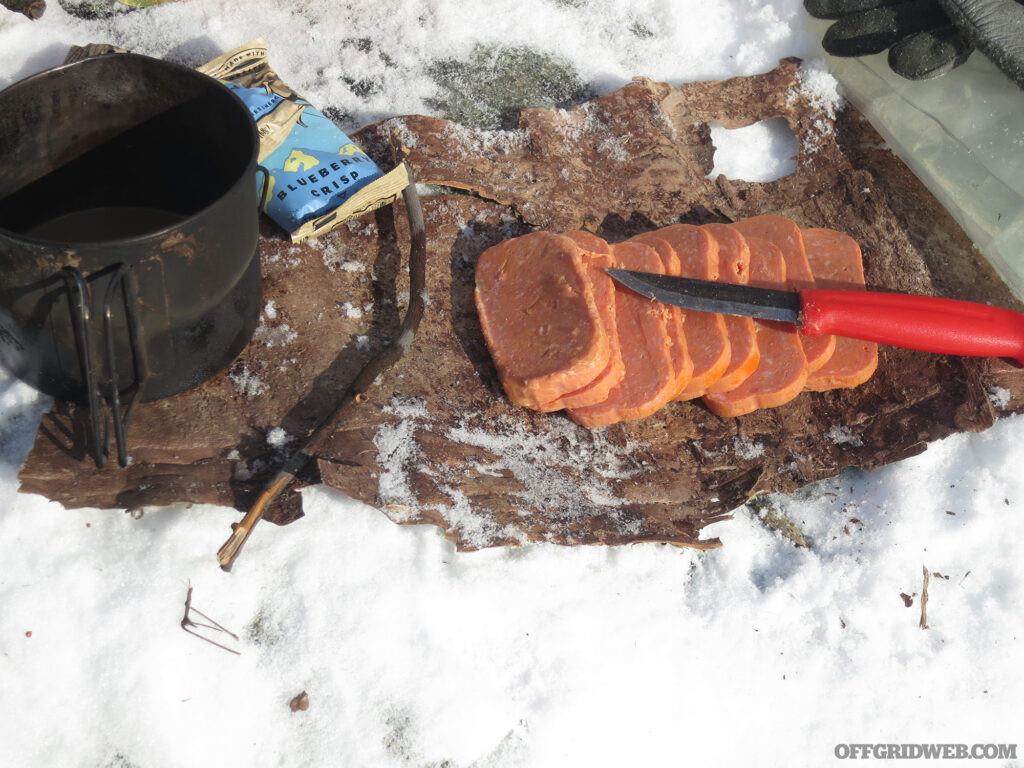
Above: Birchbark is versatile in the woods as a cutting board, serving platter, sitting pad, and ground insulation.
Closing Thoughts
Camping in winter is a lot of fun, but weather can change quickly, and you’ll end up in serious trouble if you’re not prepared. It’s crucial to take proper measures to stay safe and comfortable. First, ensure you have warm and waterproof clothing, including layers to keep you insulated. Next, keep your body temperature up by staying active and eating high-calorie foods. If you’re in an emergency, it’s essential to have the right gear, such as a sturdy shelter and a reliable heat source. Finally, be prepared to improvise, such as building a shelter from natural materials or digging into the snow for added insulation.
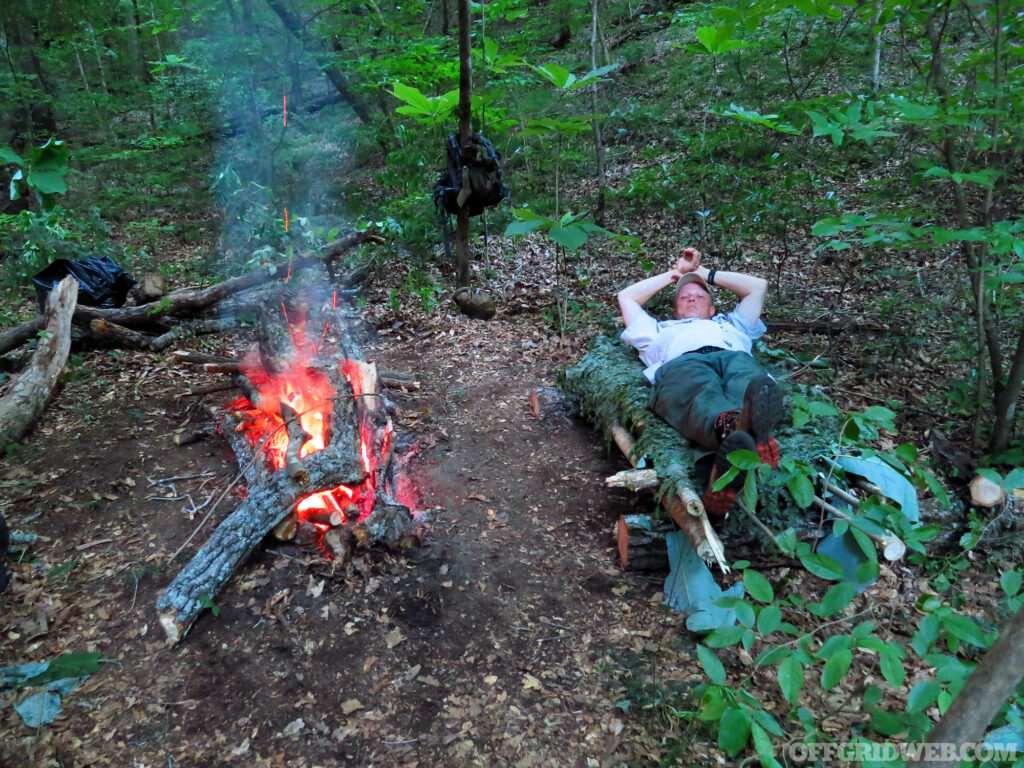
Above: A long-fire is an excellent way to stay warm and cook in cold weather, especially if you need to sleep next to it.
About the Author
Adventurer, writer, photographer, and survival instructor for Randall’s Adventure & Training, Reuben Bolieu has spent most of his life hiking and backpacking through the wildernesses of the world. He has traveled abroad in extreme environments and seeks out primitive survival techniques, construction, and uses of knives and edged tools. Bolieu has published many articles on survival, knife and tool use, and woodcraft. He remains a lifetime student of survival.
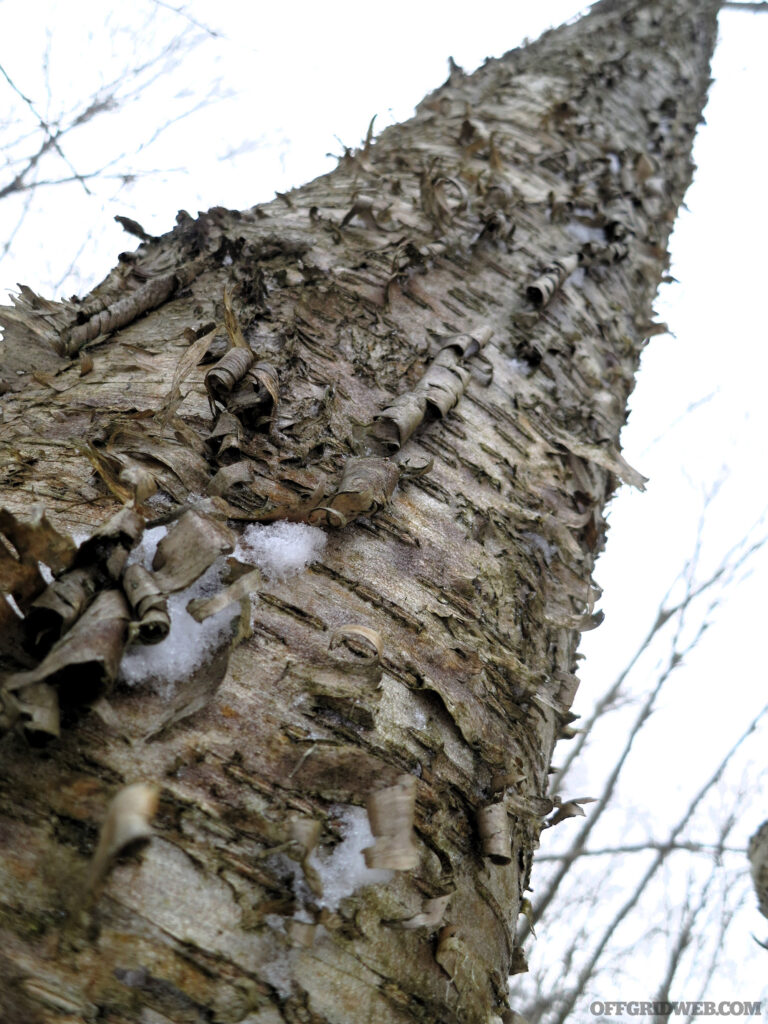
Above: Yellow Birch bark is an excellent resource in the wilderness. The bark is flammable, and larger pieces can be used for insulation and mats.
Read More
Subscribe to Recoil Offgrid's free newsletter for more content like this.
Editor's Note: This article has been modified from its original print version for the web.
The post Let It Snow: Cold Weather Tips appeared first on RECOIL OFFGRID.
By: Patrick Diedrich
Title: Let It Snow: Cold Weather Tips
Sourced From: www.offgridweb.com/survival/let-it-snow-cold-weather-tips/
Published Date: Sat, 09 Mar 2024 12:00:38 +0000
------------------------
Did you miss our previous article...
https://bushcrafttips.com/bushcraft-news/read-this-before-buying-survival-food
 What is BushcraftSurvival SkillsToolsVideosBushcraft CampsBushcraft KitsBushcraft ProjectsPrivacy PolicyTerms And Conditions
What is BushcraftSurvival SkillsToolsVideosBushcraft CampsBushcraft KitsBushcraft ProjectsPrivacy PolicyTerms And Conditions
